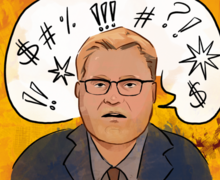Fire station closest to university hill area may close amid budget cuts
Jenny Jakubowski | Staff Photographer
Lonnie Johnson, president of the Syracuse Fire Fighters Association, is concerned about the consequences of the potential closure of Fire Station No. 7., the oldest firehouse in Syracuse, and the closest to SU. Johnson said budget cuts are the main reason it may close.
Budget deficits could lead to the closure of the fire station closest to Syracuse University.
“It’s all about the Benjamins,” said Mark McLees, chief of the Syracuse Fire Department. “I wish it was easy, but it’s not. It’s just reality.”
Fire Station No. 7, located at 1039 E. Fayette St., is the closest station to the Hill area, McLees said. It is also the oldest and most rundown station in the city.
Necessary repairs of the floors, windows and bathrooms would be expensive and temporary, he said, but construction of a new firehouse would also be expensive, costing between $7-$10 million, he said.
While McLees emphasized that the future of the station has not been decided, he said he does not expect to receive this money.
McLees said he submitted his budget report to the city last week, but will not know for months how much money will be given to the fire department. Money from the state’s Aid and Incentives to Municipalities program, property taxes and sales taxes will all factor into the amount of money the city allocates to the fire department.
The city is faced with a difficult decision, he said. Many universities, religious institutions and downtown businesses have tax breaks which, among other factors, decrease the amount of revenue the city has to disperse, he said.
“The limited resources available have to be spread out,” McLees said. “Everybody has their hand out, including me.”
Fire Station No. 7 serves approximately half of Syracuse, covering from downtown to the Eastside, said Lonnie Johnson, president of the Syracuse Fire Fighters Association.
The station responded to almost 6,000 calls last year, he said. Engine 7, which is stationed there, responded to more calls than any other engine in the city. Only one other mini-truck responded to more calls than Mini 7, which also operates out of Fire Station No. 7, he said.
Fire Station No. 7 also responded to more calls from SU than any other station, Johnson said. He said it is the closest station to some of the city’s most valuable infrastructures, including hospitals and universities.
Firefighters who work in Fire Station No. 7 are familiar with these unique buildings, which make them valuable as first responders.
“If there’s a fire in one of these buildings, there’s zero visibility,” Johnson said. “You have to feel your way through.”
If the station closes, its firefighters, who are the most familiar with the buildings, will most likely work out of different stations, Johnson said. Therefore, they would necessarily no longer be first responders.
Additionally, the closure of the station would increase the length of time it takes responders to reach fires in the area, which would enable fires to grow or worsen, Johnson said.
“It jeopardizes the students, the faculty and the community,” he added. “It also jeopardizes the firefighters.”
Lance Denno, a retired deputy chief for the Syracuse Fire Department and current Syracuse Common Councilor, said in an email he was concerned about the consequences of closing the station in regard to public safety.
He said the number of firefighters on duty at any given time is 69, the lowest in more than 50 years. At the same time, the number of emergencies has been rising rapidly, he said.
The closure of Fire Station No. 7 “could result in a reduction of the on-duty firefighting and emergency response manpower,” Denno said. “Such a reduction would critically impair public safety and firefighters’ safety as well.”
McLees, the fire chief, also said response time and public safety are serious concerns. While he said no plan has been determined yet, if the station closes, he said it is possible that average response times could stay the same.
“Response time is a function of a lot of things,” he said, explaining that the fire department always directs calls to the closest station that is available, which is not always the closest station physically.
McLees also emphasized that the firefighters themselves are more critical to public safety than the firehouse.
“The people do the work,” he said. “That’s the most important part — the people, not the fire station.”
Published on January 24, 2013 at 3:01 am





